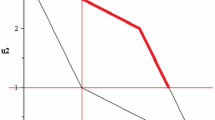Abstract
How cooperation evolves and manifests itself in the thermodynamic or infinite player limit of social dilemma games is a matter of intense speculation. Various analytical methods have been proposed to analyze the thermodynamic limit of social dilemmas. In this work, we compare two analytical methods, i.e., Darwinian evolution and Nash equilibrium mapping, with a numerical agent-based approach. For completeness, we also give results for another analytical method, Hamiltonian dynamics. In contrast to Hamiltonian dynamics, which involves the maximization of payoffs of all individuals, in Darwinian evolution, the payoff of a single player is maximized with respect to its interaction with the nearest neighbour. While the Hamiltonian dynamics method utterly fails as compared to Nash equilibrium mapping, the Darwinian evolution method gives a false positive for game magnetization—the net difference between the fraction of cooperators and defectors—when payoffs obey the condition \(a+d=b+c\), wherein a,d represent the diagonal elements and b,c the off-diagonal elements in a symmetric social dilemma game payoff matrix. When either \(a+d \ne b+c\) or when one looks at the average payoff per player, the Darwinian evolution method fails, much like the Hamiltonian dynamics approach. On the other hand, the Nash equilibrium mapping and numerical agent-based method agree well for both game magnetization and average payoff per player for the social dilemmas in question, i.e., the Hawk–Dove game and the Public goods game. This paper thus brings to light the inconsistency of the Darwinian evolution method vis-a-vis both Nash equilibrium mapping and a numerical agent-based approach.
Graphic abstract





Similar content being viewed by others
Data availability statement
The data supporting this study’s findings are available within the article and Appendix.
References
C. Benjamin, S. Sarkar, The emergence of cooperation in the thermodynamic limit. Chaos Solitons Fractals 135, 109762 (2020)
C. Benjamin, S. Sarkar, Triggers for cooperative behaviour in the thermodynamic limit: a case study in public goods game. Chaos 29(5), 53131 (2019)
C. Adami, A. Hintze, Thermodynamics of evolutionary games. Phys. Rev. E 97, 062136 (2018)
P. Ralegankar, Understanding emergence of cooperation using tools from thermodynamics. (2018). https://guava.physics.uiuc.edu/~nigel/courses/569/Essays_Spring2018/Files/Ralegankar.pdf
P. Altrock, A. Traulsen, Deterministic evolutionary game dynamics in finite populations. Phys. Rev. E 80, 011909 (2009)
E. Ising, Beitrag zur Theorie des Ferromagnetismus. Z. Physik 31, 253–258 (1925)
C. Benjamin, A. Dash, Thermodynamic susceptibility as a measure of cooperative behavior in social dilemmas. Chaos 30, 093117 (2020)
S. Galam, B. Walliser, Ising model versus normal form game. Physica A 389, 481 (2010)
A. Bladon, T. Galla, A. McKane, Evolutionary dynamics, intrinsic noise, and cycles of cooperation. Phys. Rev. E 81, 066122 (2010)
S. Schecter, H. Gintis, Game Theory in Action: An Introduction to Classical and Evolutionary Models (Princeton University Press, Princeton, 2016)
F. Reif, Fundamentals of Statistical and Thermal Physics. Tokyo: McGraw-Hill Kogakusha (1965)
Acknowledgements
The grants have funded this study: (1) Josephson junctions with strained Dirac materials and their application in quantum information processing, SERB Grant No. CRG/20l9/006258, and (2) Nash equilibrium versus Pareto optimality in N-Player games, SERB MATRICS Grant No. MTR/2018/000070.
Author information
Authors and Affiliations
Contributions
CB gave the initial idea for the project, edited the paper, and wrote the code in Python 3. He also administered the project. He provided the key references and instructed the other author to initiate him into the project. CB replied to the reviewer’s queries and made changes to the manuscript as required. AKUM wrote the first draft of the paper, made the graphs and did the calculations, and wrote code in Python 2.7.
Corresponding author
Ethics declarations
Conflict of interest
The authors have no conflicts to disclose.
Appendix A: Agent-based simulation
Appendix A: Agent-based simulation
The python3 code we used for finding the magnetization vs. reward graph for the Hawk–Dove game (see Fig. 1) using agent-based simulation is given below.

The code is the same for simulating the public goods game, except for the energy matrix, where E is negative of the public goods game payoff matrix.
Rights and permissions
Springer Nature or its licensor (e.g. a society or other partner) holds exclusive rights to this article under a publishing agreement with the author(s) or other rightsholder(s); author self-archiving of the accepted manuscript version of this article is solely governed by the terms of such publishing agreement and applicable law.
About this article
Cite this article
Benjamin, C., U.M., A.K. Nash equilibrium mapping vs. Hamiltonian dynamics vs. Darwinian evolution for some social dilemma games in the thermodynamic limit. Eur. Phys. J. B 96, 105 (2023). https://doi.org/10.1140/epjb/s10051-023-00573-4
Received:
Accepted:
Published:
DOI: https://doi.org/10.1140/epjb/s10051-023-00573-4




